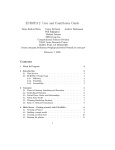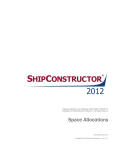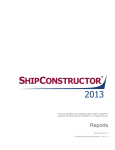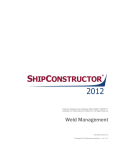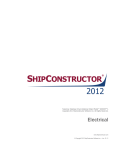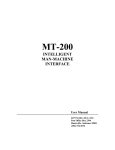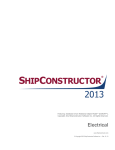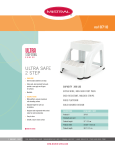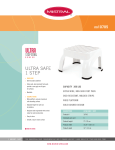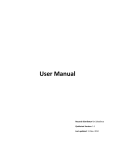Download Standard Assemblies - ShipConstructor Software Inc.
Transcript
Standard Assemblies www.ShipConstructor.com © Copyright 2011 ShipConstructor Software Inc. – Jun. 17, 11 ShipConstructor 2012 Standard Assemblies Published 2011-06-17 Copyright Copyright © 2011 ShipConstructor Software Inc. Information in this ShipConstructor manual is the property of ShipConstructor Software Inc. No part of it can be reproduced, translated, resold, rented, adapted, modified, stored in a retrieval system or transmitted in any form or by any means, in whole or in part. All Rights Reserved. Trademarks ShipConstructor AutoMagic SmartParts Database Driven Relational Object Model DDROM Are all registered trademarks of ShipConstructor Software Inc. ShipConstructor Software Inc. Suite 304 3960 Quadra Street Victoria, BC Canada V8X 4A3 Toll Free: Phone: Fax: 1-888-210-7420 1-250-479-3638 1-250-479-0868 Information: Support: Sales: [email protected] [email protected] [email protected] Website: www.ShipConstructor.com SHIPCONSTRUCTOR LICENSE AGREEMENT BEFORE PROCEEDING WITH THE INSTALLATION, YOU MUST ACCEPT THE TERMS OF THIS AGREEMENT. INDICATE YOUR ACCEPTANCE OR REJECTION OF THIS AGREEMENT BY CLICKING ON THE APPROPRIATE BUTTON. IF YOU CLICK ON “REJECT,” INSTALLATION WILL ABORT. License Grant. ShipConstructor Software Inc., #304 – 3960 Quadra Street, Victoria, B.C. Canada, V8X 4A3 (“SSI”) grants to the person accepting this Agreement (the “Licensee”) a non-exclusive, non-transferable right to use (the “License”) in object code form those program modules, application programming interface (“API”), any other materials provided by SSI under this Agreement, and all upgrades, revisions, fixes, updates or enhancements to any of the foregoing (“Licensed Materials”) specified in the Licensee’s purchase order or request (“Invoice) solely on the software and hardware listed in the Licensed Materials manual (“System Configuration”). Academic Institutions/Trial Versions. A. In the event that the Licensee qualifies as an academic institution user in accordance with SSI’s specifications (an “Academic Licensee”), the Academic Licensee and its faculty, employees and students may use the Licensed Materials for the singular purpose of either teaching, training users or undertaking research provided that the Licensed Materials, and all copies of the Licensed Materials, remain at all times at the Academic Licensee’s premises and the Licensed Materials are used for no other purpose than that set forth above. The above restrictions are in addition to the restrictions on use set out in Section 5 below. B. In the event that the Licensee receives a trial version of the Licensed Materials for evaluation purposes, the terms and conditions of this Agreement, excluding Sections 15-19, shall continue to apply subject to the following provisions: the License pursuant to Section 1 above shall terminate at the end of the specified trial period; the Licensee shall return the Hardware Key to SSI immediately upon expiry of the specified trial period and in any event within 28 days of the expiry of the specified trial period; in the event that the Licensee does not return the Hardware Key in accordance with Section 2B.(b) above, SSI shall be entitled to invoice the Licensee for and the Licensee shall pay for the costs of the Hardware Key plus all shipping and handling expenses and SSI administrative charges; and in the event that the Licensee elects to and does acquire a License, the terms and conditions of this Agreement, excluding Section 2B herein, shall continue on and apply. Ownership. All rights, title and interests in and to the Licensed Materials and related documentation shall remain the sole property of SSI. Licensee shall not remove or alter any proprietary rights notices on the Licensed Materials and the documentation, and shall reproduce such notices on any copies that it makes. Licensee shall be liable for the security of the Licensed Materials and the documentation in its possession. Expertise Required. Licensee is responsible for evaluating whether the Licensed Materials meets Licensee’s requirements, and for operating the Licensed Materials and the results obtained. The Licensed Materials are intended for ship modeling and construction purposes only, and must be used by a person who has expertise and knowledge in this field. The Licensed Materials requires independent confirmation of the reliability and accuracy of all designs, drawings and other Licensed Materials output. An SSI representative may be made available under a separate consulting agreement, as the Licensee’s request to provide training and consultation on the operation or integration of licensed materials. Limitations on Use. Licensee shall: (a) not make more copies of the Licensed Materials than are necessary for the Licensee’s installation of the Licensed Materials and shall only create backup copies for archival or emergency restart purposes; (b) maintain a log of the number of and location of all originals and copies of the Licensed Materials; (c) include SSI’s copyright, trademark and proprietary notices on any complete or partial copies of the Licensed Materials in the same form and location as the notice on any original work; (d) not attempt to defeat any copy protection; (e) not modify, any documentation, including any user manuals; (f) not modify, translate, reverse engineer, decompile or disassemble the Licensed Materials; (g) not sublicense, transfer, assign, sell, loan, rent or lease the Licensed Materials other than as permitted in this Agreement; (h) use the Licensed Materials for its own internal use only; (i) not permit any third party to use the Licensed Materials; and (j) thoroughly test any and all custom interfaces in accordance with general engineering principles. 6. Delivery and Installation. All Licensed Materials will be delivered in an electronic format by media or method as SSI may elect and will be sent to the Licensee’s designated email address or shipping address as specified in the Invoice. Licensee agrees to be responsible for installation of the Licensed Materials. 7. Term of License. The License term commences on the delivery of the Licensed Materials to the Licensee, and, subject to Section 2B above, is either perpetual if so requested on the Order, or on a month to month rental or lease basis. If Licensee chooses a lease option the license converts to a perpetual term on Licensee’s payment of the balance of the perpetual License fee (prior monthly payments receiving 80% credit). All Licenses are subject to termination in accordance with this Agreement. 8. System Configuration. Operation of the Licensed Materials requires use of the specified System Configuration, which Licensee shall acquire and implement. SSI shall not be responsible for any operational problems caused by the System Configuration. 9. Hardware Keys. Licensed Materials use requires “Hardware Keys” supplied by SSI, which can be used only at the site(s) authorized by SSI. In the event of a failure of the Licensee’s System Configuration, the Licensee may upon advising SSI use the Hardware Keys and Licensed Materials on another system and/or location. 10. License Fees. Licensee shall pay to SSI the License fees applicable for the Licensed Materials as set out in and in accordance with SSI’s Invoice. 11. Services. Support services after the Warranty Period (as defined in Section 15 below) are provided by SSI under the terms of the SSI Subscription Agreement. Installation, consulting, training and implementation services, if requested by the Licensee, shall be provided by separate agreement and at an additional charge. 12. Taxes. All amounts payable by Licensee to SSI are exclusive of all commodity taxes, including but not limited to applicable sales, use, value added, custom duties, excise taxes and other similar government charges, all of which will be paid by Licensee. If Licensee is required by law to withhold any taxes, then Licensee shall pay SSI a gross amount of money such that the net amount received by SSI after deducting or withholding the required taxes is equal to the amount of the fee originally charged by SSI. 13. Interest Charges. If any amount payable under this Agreement is not paid within 30 days of becoming due, SSI shall have the right to impose a charge of 2% per month (24% annually) on the unpaid balance of the amount, from the due date until the date of receipt of all amounts in arrears including interest. 14. Purchase Orders. Any purchase order (an “Order”) delivered by Licensee shall at all times be deemed to incorporate this Agreement by reference and shall be subject to the applicable provisions of this Agreement. Any provisions of an Order shall not apply and shall not be binding upon SSI unless they relate to information which was requested by SSI. In the event of a conflict or an inconsistency between the provisions of an Order and the terms and conditions of this Agreement, this Agreement shall govern and supersede to the extent of such conflict or inconsistency. 15. Limited Warranty. SSI warrants that during a period of 90 days from the date of delivery of the Licensed Materials to Licensee (the “Warranty Period”), the Licensed Materials will perform substantially in accordance with the Licensed Materials documentation specifications, when used in accordance with this Agreement on a properly operating System Configuration. SSI’s sole obligation under this Warranty, and Licensee’s exclusive remedy, shall be to use reasonable commercial efforts to correct Errors (a bug, defect or other problem incurred by a user in operating the Software that prevents the Software from performing in a manner consistent with the applicable specifications set out in the User Manual) that the Licensee identifies to SSI through fixes or workarounds free of charge. If SSI determines that it is unable to make the Licensed Materials perform substantially as warranted, Licensee may terminate the License and receive a refund of a portion of the License Fees paid to date. 16. WARRANTY EXCLUSIONS. THE LIMITED WARRANTY CONTAINED IN SECTION 15 IS IN LIEU OF ALL OTHER WARRANTIES, EXPRESS OR IMPLIED. ALL OTHER CONDITIONS, WARRANTIES, AND REPRESENTATIONS, EITHER EXPRESS OR IMPLIED, ARE EXCLUDED, INCLUDING BUT NOT LIMITED TO CONDITIONS, REPRESENTATIONS AND WARRANTIES RELATING TO MERCHANTABILITY AND FITNESS FOR A PARTICULAR PURPOSE. SSI DOES NOT WARRANT THAT THE LICENSED MATERIALS ARE COMPLETELY ERROR FREE OR THAT ITS OPERATION WILL BE CONTINUOUS AND UNINTERRUPTED. 17. Maintenance Services. Licensee may elect, at the expiry of the Warranty Period, to obtain maintenance, support and upgrade services from SSI in accordance with and subject to the terms of SSI’s standard Subscription Agreement. 18. Loss of Data. SSI shall not be responsible for any loss of or damage to files or data caused by the Licensed Materials, or be required to restore or rebuild files or data. Licensee shall implementing adequate backup procedures to avoid any loss of files and data. 19. Modifications. SSI may, from time to time, provide the Licensee with revisions to the Licensed Materials (the “Revised Licensed Materials”). The Licensee shall test any external applications using the revised API before implementing the new version. While it is SSI’s intention that the Revised Licensed Materials shall be backwardcompatible with the immediately prior version of the Licensed Materials, SSI does not guarantee or warrant that this shall be so, and SSI shall have no liability whatsoever to the Licensee for any failure of the Revised Licensed Materials to be backward compatible with any prior version of the Licensed Materials. Modifications requested by the Licensee shall be subject to prior written agreement as to scope and fees payable. Ownership of all Licensed Materials modifications shall vest in SSI. SSI does not warrant, guarantee or otherwise commit to supporting Licensed Materials that has been superseded by Revised Licensed Materials. 20. Confidential Information. Each party will not use the confidential information of the other party for any purpose except for the purpose described in this Agreement, and shall not disclose it to any other person except on a confidential basis to its employees and representatives who have a need-to-know the confidential information for such purposes. This Section 23 shall not apply to confidential information which (a) is or has become readily available to the public in the same form other than by an act or omission of the receiving party, (b) was lawfully obtained in the same form by the receiving party from a third party not under an obligation of confidence to the disclosing party, (c) was in the receiving party’s possession in the same and material form prior to its receipt from the disclosing party and did not otherwise originate from the disclosing party, or (d) is required to be disclosed by operation of law. 21. Termination. This Agreement may be terminated by either party, immediately by written notice, if the other party commits a breach of any material provision of this Agreement, including a failure to make payment when due, and fails to correct or rectify such breach within 30 days of receipt of the notice requesting it to do so. SSI shall be entitled to place time-lock devices and other disabling features in the Licensed Materials that become effective in the event that the Licensee has failed to comply with its payment obligations hereunder and as set out in SSI Invoices. 22. Effect of Termination. Upon termination of this Agreement Licensee shall immediately cease using the Licensed Materials, and within 14 days of termination return all Hardware Keys to SSI. 23. CONSEQUENTIAL DAMAGES. IN NO EVENT SHALL SSI BE LIABLE FOR ANY LOSS OF DATA OR PROFITS, ECONOMIC LOSS OR SPECIAL, INDIRECT, INCIDENTAL, CONSEQUENTIAL OR PUNITIVE DAMAGES WITH RESPECT TO THIS AGREEMENT OR THE LICENSED MATERIALS, HOWEVER CAUSED, EVEN IF SSI HAD OR SHOULD HAVE HAD ANY KNOWLEDGE OF THE POSSIBILITY OF SUCH DAMAGES. 24. DAMAGES LIMITATION. THE MAXIMUM LIABILITY OF SSI FOR ALL CLAIMS AND DAMAGES OF ANY KIND, WHETHER FOR FUNDAMENTAL BREACH OR ANY OTHER CAUSE UNDER THIS AGREEMENT, SHALL BE LIMITED IN THE AGGREGATE TO THE TOTAL OF ALL FEES PAID BY LICENSEE. 25. LIMITATION OF NON-APPLICABILITY. IN SOME JURISDICTIONS THE EXCLUSION OR LIMITATION OF WARRANTIES OR LIABILITY MAY NOT BE APPLICABLE, AND IN SUCH JURISDICTIONS SSI HEREBY LIMITS ITS LIABILITY TO THE FULLEST EXTENT PERMITTED BY LAW. 26. Applicable Law. This Agreement shall be subject to and construed in accordance with the laws of the Province of British Columbia, Canada, excluding its conflict of laws rules and the application of the UN Convention on Contracts for the International Sale of Goods. 27. References. SSI shall be allowed to incorporate Licensee’s name in SSI’s customer reference list and to use it for marketing. 28. Dispute. If any dispute arises under this Agreement, a good faith attempt to resolve the dispute will be made by senior management of both parties at a mutually agreeable site and time. If the parties are unable to reach agreement within 30 days after a request for such meeting, the dispute shall be referred to arbitration in English, before one arbitrator in Victoria, British Columbia, Canada, in accordance with the Commercial Arbitration Act of the British Columbia. 29. Entire Agreement. This Agreement contains the entire agreement between the parties and shall supersede all prior discussions and agreements between the parties regarding its subject matter. 30. Amendment. Any amendment of this Agreement must be in writing and signed by duly authorized representatives of the parties. 31. Waiver. The waiver by any party of a breach by the other party of this Agreement shall not be construed as a waiver by such party of any succeeding breach by the other party of the same or another provision. 32. Assignments. Licensee may not assign or transfer the License or Licensee’s rights or obligations under this Agreement without SSI’s prior written consent, and any such assignment or transfer without consent shall be null and void. A transfer of all or substantially all of the voting stock of the Licensee shall constitute a transfer for these purposes and shall be subject to SSI’s prior written consent. 33. Successors and Assigns. This Agreement will bind and enure to the benefit of the parties and their respective successors and permitted assigns. 34. Severability. In the event that any provision of this Agreement is declared invalid, illegal or unenforceable by a court having jurisdiction, then the remaining provisions shall continue in full force and effect. 35. Force Majeure. Except as related to Licensee’s obligation to make payments to SSI, neither party shall be liable for delays or non-performance if such delays or non-performance are beyond such party's reasonable control. A delayed party shall promptly notify the other party in writing stating the cause of the delay and its expected duration and shall use commercially reasonable efforts to remedy a delay or non-performance as soon as reasonably possible. 36. Survival. The provisions of Sections 0, 5, 10, 12, 13, 16 and 18-28 shall survive the expiry or termination of this Agreement. 37. Language. It is the express will of the parties that this Agreement and related documents have been prepared in English. C’est la volonté expresse des parties que la présente Convention ainsi que les documents qui s’y rattachent soient rédiges en anglais. #363338 28/05/2010 Contents Contents SHIPCONSTRUCTOR LICENSE AGREEMENT ......................................................................................................................... ii Standard Assemblies 3 Naming Conventions............................................................................................................................................ 3 Standard Assembly ..................................................................................................................................................................3 Parts in Standard......................................................................................................................................................................3 Spools in Standard ...................................................................................................................................................................3 Drawing Templates.............................................................................................................................................. 3 Catalog................................................................................................................................................................... 4 Types...........................................................................................................................................................................................4 Standards...................................................................................................................................................................................4 Details.........................................................................................................................................................................................4 Preview.......................................................................................................................................................................................5 Editing a Standard Assembly Standard ................................................................................................................................5 Import.........................................................................................................................................................................................5 Export..........................................................................................................................................................................................5 Usage..........................................................................................................................................................................................5 Closing the Catalog...................................................................................................................................................................5 Modeling a Standard Assembly Standard........................................................................................................ 5 Structure.....................................................................................................................................................................................5 Pipe/HVAC .................................................................................................................................................................................6 Equipment..................................................................................................................................................................................6 Other Exclusions........................................................................................................................................................................6 Assembly Structure ..................................................................................................................................................................6 Using Standard Assemblies in Model Drawings.............................................................................................. 8 Insertion .....................................................................................................................................................................................8 Editing.........................................................................................................................................................................................9 Anchor\Unanchor .................................................................................................................................................................. 10 Production Output ..............................................................................................................................................10 Plate Nesting .......................................................................................................................................................................... 10 Profile Plots ............................................................................................................................................................................ 11 Reports.................................................................................................................................................................11 Index 13 i Standard Assemblies 1 Standard Assemblies Standard Assemblies A standard assembly is a logical grouping of parts and components which can be used multiple times in one or more projects but only has to be modeled once. Naming Conventions Manager > General > Naming Conventions Standard Assembly The naming convention used when placing a standard assembly in a model drawing. Users will need at least one naming convention of this type defined in order to insert standard assemblies into their model drawings. Available Naming Elements • Static – User defined text • AutoNumber – Auto-generated number • ModelDrawing – Name of the current model drawing • Standard – Name of the standard assembly standard Parts in Standard The naming convention used for parts within a standard assembly standard. Users will need at least one naming convention of this type defined in order to created parts in a standard assembly standard. Available Naming Elements • Static – User defined text • AutoNumber – Auto-generated number • Standard – Name of the standard assembly standard Spools in Standard The naming convention used for spools in a standard assembly standard. Users will need at least one naming convention of this type defined in order to created spools in a standard assembly standard. Available Naming Elements • Static – User defined text • AutoNumber – Auto-generated number • Spec – Name of the pipe or HVAC specification the parts in the spool belong to. Drawing Templates Users can define multiple standard assembly drawing templates which will be used when editing a standard assembly standard for the first time. Users can create new standard assembly templates through Navigator or can manually copy existing drawing templates to their Template\StandardAssembly folder under the project folder. If copying an existing 3 Standard Assemblies template over manually users will need to open each copied template through Navigator to register it to the current project. Catalog Standard assembly standards are created through Manager using the Standard Assembly Catalog Manager > Standard Assembly > Standard Assembly Catalog Types Types provide a way for users to organize their standard assembly standards into a folder like structure. Use the New Type and Delete Type buttons to create and delete types. You will need to have at least one type to be able to create a standard assembly standard. Note: You cannot delete a type if a standard assembly standard is assigned to that type or any of any of its sub types. Standards The standard assembly standards in the project that are assigned to the selected type and all sub types are listed here. Here users can rename standards and assign them different types. Use the New Standard and Delete Standard buttons to create and delete standard assembly standards. Note: Users will not be allowed to delete a standard assembly standard if it is currently used in a model drawing. Details Details of the selected standard assembly standard are shown here. (i.e. Insertion Points) 4 Standard Assemblies Preview A preview of the selected standard assembly standard is shown here. The preview shows the view of the standard assembly standard at the time of the last save as seen by the user. Editing a Standard Assembly Standard To edit a standard assembly standard select it in the Standards area and click the Edit Std. Drawing button. This will prompt you to save any changes you have made in the Standard Assembly Catalog and open up a model drawing with the standard assembly standard in it. In the model drawing users can create\edit\delete parts and assemblies associated with the standard assembly standard. See the Modeling a Standard Assembly Standard section. Note: If you have multiple standard assembly drawing templates you will be prompted to select which template to use for the standard assembly standard the first time it is edited. Import To import standard assembly standards from another project with the same database version click the Import button. Users will be prompted to select a source project and then all importable standard assembly standards will be listed so the user can choose which to import. Note: Importing standard assembly standards from an XML file is not supported in the current ShipConstructor release. Please look for it in a future release. Export This is not supported in the current ShipConstructor release. Please look for it in a future release. Usage If a standard assembly standard is in use in the current project, click the Usage button to get information on where it is being used. Closing the Catalog If changes may have been made to a standard assembly standard that is in use in a model drawing the user will be prompted to update the model drawings which contain the standard assemblies. It is strongly recommended that users allow the update of the model drawings to proceed or else information about the standard assemblies in these drawings may not be up-to-date. Modeling a Standard Assembly Standard Structure Modeling structure parts in a standard assembly standard is almost the same as modeling structure within a single structure model drawing. Certain operations and interactions with other drawings are limited or restricted but almost all of the structure functionality and operations are available to be used in a standard assembly standard. Stiffener-Plate Cutouts Cutouts can be added in plate parts from stiffeners within the same standard assembly but cutouts can’t be created in plate parts in a standard assembly from stiffeners that are not within that standard assembly. Stiffeners in a standard assembly can make cutouts in non-standard assembly plate parts in a model drawing. Assigning Parts to Assemblies The Product Hierarchy page of the Part Properties window will not be shown when creating\editing structure parts. Users will need to use the Standard Assembly Standard Hierarchy window to assign parts to assemblies. See the Assembly Structure section. 5 Standard Assemblies Exclusions The following entities cannot be included in a standard assembly: • Standard Parts • Curved Plate Parts • Plank Parts • Datum Lines • Hull Trace Construction Lines • Planar Group Construction Lines Pipe/HVAC Modeling pipe and HVAC parts in a standard assembly standard is almost the same as modeling these parts in a single model drawing. Certain operations and interactions with other drawings are limited or restricted but almost all of the pipe and HVAC functionality and operations are available to be used in a standard assembly standard. When modeling pipe and HVAC parts user will only need to specify a Specification they are working within and not a System\Branch. Note: Once a standard assembly standard is used in a model drawing users will not be able to add new pipe or HVAC parts to the standard. Please look for this restriction to be removed in a future release. Spools Before a standard assembly standard can be saved all pipe and HVAC parts must either be spooled or set to no-spool. If a user attempts to save when there are some parts that are not spooled or set to no-spool then a log file will be presented to the user listing the parts that need to be corrected before the save can be tried again. Exclusions The following entities cannot be included in a standard assembly: • Hangers • Supports Equipment Equipment can be inserted and manipulated just as in an equipment model drawing. Other Exclusions The following entities cannot be included in a standard assembly: • Penetrations • Space Allocations Assembly Structure While modeling a standard assembly standard users can set up the assembly structure that the standard assembly will use. To make changes to the assembly structure: 1. Choose ShipConstructor > Product Hierarchy The Standard Assembly Standard Hierarchy appears 6 Standard Assemblies 2. Create\edit\delete assemblies and assign parts just like you would in the main product hierarchy Purchased Assemblies Assemblies in a standard assembly standard can be designated as purchased. This will allow the user to easily filter the parts in these assemblies out of some production output. (i.e. If a ladder is purchaced as a complete unit it can be modeled as a standard assembly using plate parts and stiffeners, placed in an assembly designated as purchased and the user will have the option to not include these parts in their plate nests and profile plots) To designate an assembly as purchased: 1. In the Standard Assembly Standard Hierarchy window select the assembly and choose Tools > Assembly > Edit… The Edit Assembly window appears 7 Standard Assemblies 2. Check the Purchase box 3. Click OK The selected assembly and all sub-assemblies will now be designated as Purchased. All standard assemblies using the current standard which exist in model drawings will be updated to match the new assembly attributes. Using Standard Assemblies in Model Drawings Insertion 1. 8 Choose SC Standard Assembly > Insert Standard Assembly Standard Assemblies The Standard Assembly Wizard appears 2. Select the standard assembly standard to insert and click Next. 3. Select the assembly in the primary product hierarchy to assign the standard assembly to and click Next. 4. Select the systems\branches to assign the pipe and HVAC parts to and click Next. 5. Select the naming options for the different types of parts in the standard assembly and click Finish. 6. • Generate New Name – New part names will be generated using the current naming convention for the parts getting the lowest available auto-numbers. • Generate New Name Using Auto-Number from the part in the Standard Assembly Standard – New part names will be generated using the current naming convention for the parts but it will attempt to use the auto-number of the corresponding part in the standard assembly standard. This can allow users to set up a specific numbering sequence in the standard assembly standard that the parts can follow when inserted in the model. (i.e. A user may want their spools numbered 1, 2, 3 forward to aft. Using this option ShipConstructor will attempt to generate names for the standard assembly spools in the model following the same numbering sequence.) • Use Name from Standard Assembly Standard – The parts will use the exact name that is set in the standard assembly standard. Use the placement jig to position the standard assembly in the correct location and orientation. The standard assembly is created and placed in the drawing at the correct location. Editing 1. Choose SC Standard Assembly > Edit Standard Assembly 2. Edit the systems\branches the pipes and HVAC parts are assigned to and click Next. 3. Edit the naming options for the different types of parts in the standard assembly and click Finish. The standard assembly is updated with the changes the user made. 9 Standard Assemblies Note: Users will not be able to use the AutoCAD UNDO functionality to undo the changes made during the edit of a standard assembly. Anchor\Unanchor Users can anchor and unanchor standard assemblies to restrict their movement just like a distributed systems part. Production Output Plate Nesting Users have the ability to filter out plate nestable parts which reside in standard assemblies so they will not be included in plate nests. 10 • Standard Assemblies – If unchecked no plate nestable parts which reside in standard assemblies will show up or be selectable in the assembly\part tree on the left. • Purchased - If unchecked no plate nestable parts which reside in standard assemblies and are assigned to assemblies marked as purchased will show up or be selectable in the assembly\part tree on the left. Standard Assemblies Profile Plots Users have the ability to filter out profile parts which reside in standard assemblies so profile plots will not be created for them. • Std Assemblies – If unchecked no profile parts which reside in standard assemblies will show up or be selectable in the assembly\part tree. • Purchased - If unchecked no profile parts which reside in standard assemblies and are assigned to assemblies marked as purchased will show up or be selectable in the assembly\part. Reports A new Purchased field was added for all parts and assemblies which will indicate if the part or assembly has been marked as Purchased. This field will always be false for parts and assemblies that are not part of a standard assembly. A new section was added for standard assemblies allowing users to include them in their existing reports or to generate reports on only standard assemblies. 11 Index Index No index entries found. 13























